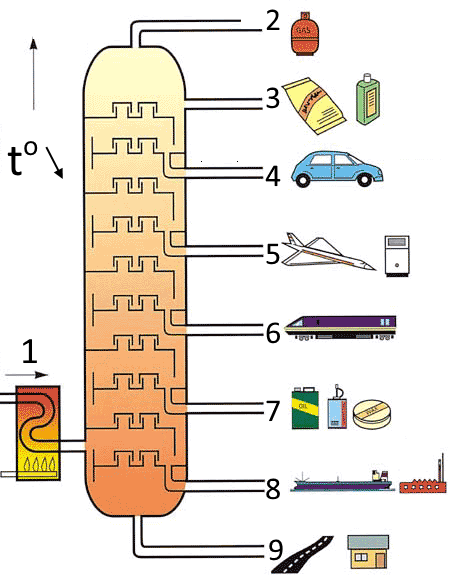







Search:
Millions of years ago in coastal seas:

1. The plankton is abundant in the high seas. 2. In coastal lagoons evaporation is intense. 3. The evaporated water is replaced by water of the open sea sucked in with its plankton. 4. The dead plankton settles, mixed with other evaporites in a poorly oxygenated medium.
Nowadays:

0) In anaeorobic conditions and under the influence of high pressures, the organic substances have lost sulfur and nitrogen and are transformed into a mixture of carbon and hydrogen compounds (hydrocarbons): petroleum. 1) An impermeable cover layer is deposited and no longer allows less dense oil to rise on the surface. 2) The oil migrates into traps where it differentiates into liquid and gas. 3) Liquid petroleum 4) Natural gas. 5) Drilling.

Petroleum is a dark, viscous liquid. It is formed by compounds of carbon and hydrogen, hydrocarbons.
In a → refinery petroleum is separated into fractions by distillation in distillation towers (fractionating columns )

1) Crude petroleum is vaporized. Following the cooling, the temperature decreases from bottom to top. Each "level" in this tower condenses the hydrocarbons whose boiling point is higher than its temperature of the bearing, but lower than the temperatures of the lower levels. 2) At approximately 20 o C: Petroleum gases (hydrocarbons of 1 to 4 carbon atoms) 3) At approximately 70 o C: Light petroleum (hydrocarbon 5 to 9 carbon atoms) 4) At approximately 120 o C: Gasoline (hydrocarbons of 5 to 10 carbon atoms) 5) At approximately 170 o C: Kerosene (hydrocarbon of 10-16 carbon atoms) 6) At approximately 270 o C: Diesel (hydrocarbons of 14-20 carbon atoms) 7) At approximately 450 o C: Lubricating oils (hydrocarbons of 20-50 carbon atoms) 8) At approximately 600 o C: Oil (hydrocarbons of 20-70 carbon atoms) 9) At more than 600 o C: Bitumen (hydrocarbons of 70 to .. carbon atoms)
Conversions still in → refinery are processes to improve the quality of petroleum fractions (→ smaller molecules, branched molecules, cycles ...). These are reactions which are often conducted at elevated pressures and temperatures or in the presence of catalysts: Cracking Example:

Décane give propene and heptane
Isomerization Example:

Pentane gives methylbutane
Reforming Example:

Hexane gives cyclohexane and hydrogen